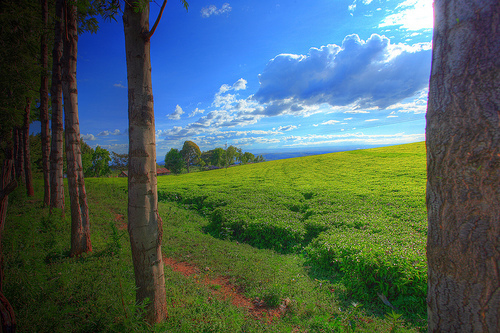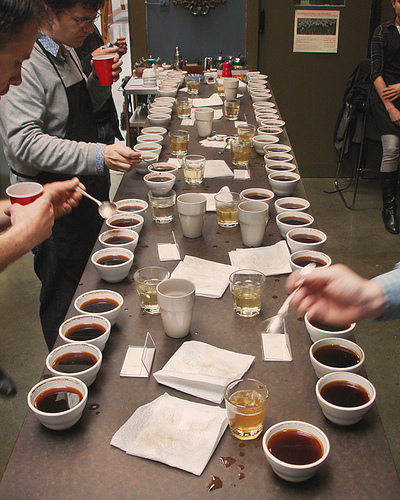Difference between Kenyan AA+ Coffee and Kenyan AA Coffee Kenya Coffee rating
Before the 1960s, Kenyan coffee was not as popular as it is now. This may be because they are not famous, or it may be because Kenyan coffee at that time was not as good as it is now. In 1954, the British colonists opened more coffee fields to the Kenyan aborigines. A few years later, when the coffee fields were almost entirely in the hands of the aborigines, the reputation of Kenyan coffee gradually established. Before that, not all British colonists were able to treat black Kenyans as kindly as Meryl Streep, the heroine out of Africa, and no one searched the coffee beans as she did. Kenyans took on all the heavy work of growing and processing coffee, forcing them to climb out of huge coffee washing tanks and trample on the fruit with their feet to facilitate fermentation. Kenyans dare not express their anger, but they have learned to resist in production. In 1952, Kenyan workers joined the entire African struggle against colonization (MAU MAU REBELLION), and the British government had to use the army to suppress it. This situation was not reversed until the colonists completely returned the coffee fields to the indigenous people. Kenyan coffee finally glows in the hands of Kenyans themselves.

Coffee fields in Kenya
Although Kenya is adjacent to Ethiopia, which is also located in East Africa, Kenyan coffee was a seed brought by the British from the Asian island of Bourbon in the early 20th century. So Kenya grows high-quality Arabica bourbon coffee. With an average elevation of 1500-2000 meters above sea level, Kenya is an excellent place to produce Arabica hard beans. In addition, there are no large-scale coffee plantations in Kenya, and coffee fields are scattered in the hands of indigenous people, so manual picking is the most common way to harvest coffee fruit here. Whenever the coffee is ripe, people go to the coffee fields seven times to pick the red coffee fruit, and then send the fresh coffee fruit to a large cleaning station, which is roughed into "parchment coffee beans", and then purchased, graded and auctioned by the government.

Kenyan coffee is directly named after the country and is divided into seven grades according to taste: AA++, AA+, AA and AB. In addition, there are 6 grades classified according to the shape of beans. Kenyan coffee is as intriguing as Kenya's natural scenery. It has a wonderful aroma and bright and lively acidity-it's hard to describe acidity literally, it has to be tasted, and it's like a wine with a hint of fruit-sometimes it's a very acidic "BlackBerry" with only a hint of sweetness, which quickly made it a favorite of the British and popular all over the continent and the world. The biggest buyers of Kenyan coffee are German and Japanese coffee merchants who have always been known for their quality and high prices, and Nordic coffee sellers are also ordering large quantities in Kenya.
Important Notice :
前街咖啡 FrontStreet Coffee has moved to new addredd:
FrontStreet Coffee Address: 315,Donghua East Road,GuangZhou
Tel:020 38364473
- Prev

Information on Kenyan Coffee the most popular single coffee wash Kenya
Caption: Kenyan coffee has a multi-layered and complex flavor, including juice-like acidity, obvious grapefruit flavor and wine mellow, medium-bodied. Origin: African / Arab processing methods: washing flavor: grapefruit flavor, berry flavor acidity: high mellow: medium food match suggestion: grapefruit, berries, seedless raisins, raisins this African high
- Next

Why do Kenyan Coffee use Elephant
Kenya is located on the equator on the Indian Ocean coast of east-central Africa, to the south of Ethiopia. There are many elephants in the tropics, and such packaging images can bring you the feeling of entering Kenya. Kenyan coffee tastes so unique that there is almost no similar coffee. Kenyan coffee is characterized by a distinctive fruity aroma. Try to find this flavor in the coffee and pay attention to how it feels in the mouth. Among them
Related
- Does Rose Summer choose Blue, Green or Red? Detailed explanation of Rose Summer Coffee plots and Classification in Panamanian Jade Manor
- What is the difference between the origin, producing area, processing plant, cooperative and manor of coffee beans?
- How fine does the espresso powder fit? how to grind the espresso?
- Sca coffee roasting degree color card coffee roasting degree 8 roasting color values what do you mean?
- The practice of lattes: how to make lattes at home
- Introduction to Indonesian Fine Coffee beans-- Java Coffee producing area of Indonesian Arabica Coffee
- How much will the flavor of light and medium roasted rose summer be expressed? What baking level is rose summer suitable for?
- Introduction to the characteristics of washing, sun-drying or wet-planing coffee commonly used in Mantenin, Indonesia
- Price characteristics of Arabica Coffee Bean Starbucks introduction to Manning Coffee Bean Taste producing area Variety Manor
- What is the authentic Yega flavor? What are the flavor characteristics of the really excellent Yejasuffi coffee beans?

